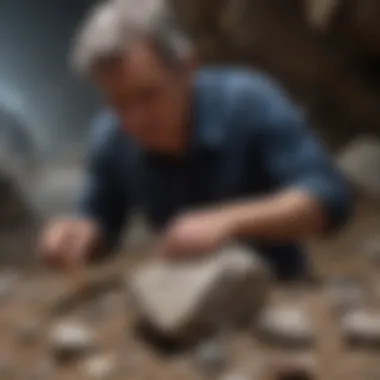Valuable Raw Rocks: A Comprehensive Exploration


Intro
In the complex realm of natural treasures, raw rocks hold a unique position. Their value spans beyond their physical composition, embodying historical significance, geological stories, and aesthetic charm. Collectors and enthusiasts venture into this fascinating world, driven by curiosity and passion for discovering hidden gems.
As we journey through the intricacies of valuable raw rocks, it is essential to understand the influences shaping their worth. From the market mechanics at play to the geological factors that contribute to their formation, each stone tells a story of its origin and journey. This guide aims to elucidate the essentials of rock collection, identifying various types and their intrinsic values.
History and Origins
Overview of Collectibles, Rocks, and Fossils
The history of collectibles, particularly rocks and fossils, traces back thousands of years. Early civilizations prized certain minerals for their perceived properties and beauty. These natural formations provided not only material benefits—like tools and ornaments—but also held cultural and spiritual significance.
Rocks and fossils have evolved into a robust market niche today. Collectors seek to acquire pieces that resonate with personal experiences or represent scientific achievement. Fossils, in particular, provide crucial insights into prehistoric life, helping scientists piece together the evolutionary puzzle of our planet.
Historical Significance and Cultural Impact
Each rock type carries its unique narrative. For instance, jade holds a prestigious place in Chinese culture, symbolizing purity and moral integrity. Similarly, lapis lazuli was cherished in ancient Egypt for its vibrant color and association with royalty. Interest in these stones has spurred trade routes, fostered cultural exchanges, and influenced artistic expressions across generations.
The cultural value of these rocks often enhances their monetary worth. Collecting raw rocks is not just a hobby; it’s a way to connect with history and heritage. Understanding this backdrop can enrich one’s appreciation for the collections they pursue.
Identification and Classification
Guide to Identifying Rocks and Fossils
Identifying rocks and fossils requires a keen eye and familiarity with various characteristics. Collectors often refer to properties such as color, texture, and luster. For beginners, a structured approach can simplify the identification process:
- Color: The hue of the rock can be an immediate indicator of its type.
- Texture: Rough or smooth surfaces can inform about the rock’s formation.
- Luster: Reflectivity can suggest whether a rock is metallic or non-metallic.
Fossils exhibit additional features. Examining the shape, size, or markings can provide clues to the organism and its environment. Knowledge of geological time periods also assists collectors in placing fossils in their chronological context.
Common Types and Variations
In the vast world of raw rocks, several types stand out due to their unique attributes:
- Igneous Rocks: Formed from cooled magma, examples include granite and basalt.
- Sedimentary Rocks: Created from particles, common varieties are sandstone and limestone.
- Metamorphic Rocks: Resulting from high pressure and temperature, such as marble and schist.
Fossil types can also vary significantly, ranging from imprints of ancient plants to bones of prehistoric animals. Each category opens doors to distinct collecting avenues, making it essential for hobbyists to delve deeper into their characteristics and significances.
Preamble to Raw Rocks of Value
The realm of raw rocks encompasses a diverse array of materials that extend beyond mere geological curiosities. These rocks can hold significant value in various contexts, including economic, aesthetic, and scientific. This exploration serves as an essential guide, not only for seasoned collectors but also for those newly embarking on their journey into this fascinating world.
Understanding raw rocks is crucial, as it allows individuals to appreciate the intrinsic and extrinsic values they present. Many rocks contain unique properties that make them sought after for personal collections or commercial investment. Moreover, the market for these items continues to grow, leading to both novice and experienced collectors making valuable discoveries.
Factors such as rarity and the demand can greatly influence the market for raw rocks. This dynamic market forces participants to stay informed about trends and pricing, ensuring informed decision-making in their purchases. Potential buyers and sellers must recognize the specific elements that contribute to a rock’s worth to effectively navigate this complex field.
Understanding Raw Rocks
Raw rocks come in various forms, from raw gemstones to more common stones that can still command high prices. Becoming familiar with different types of rocks enables collectors to make educated choices when acquiring items. It is essential to understand the characteristics that define these rocks, including hardness, color, texture, and transparency.
Furthermore, categorizing these rocks by their geological origins clarifies their formation processes and potential value. For instance, igneous, metamorphic, and sedimentary rocks all have distinct traits and are found in different environments. Collectors need to learn about these factors to assess whether specific rocks align with their collecting goals.


The Financial Aspect of Rocks
Investing in raw rocks merges passion with potential profit. The financial landscape surrounding these items can be quite varied. In some instances, rocks can appreciate over time, turning a modest investment into a valuable asset. However, this requires a substantial understanding of market trends and valuation criteria.
Buyers should consider:
- Market Demand: High demand can drive prices up significantly.
- Rarity: Unique items or variations can become highly sought after.
- Aesthetic Appeal: Beautifully polished or rare specimens often fetch higher prices.
Types of Rocks with Market Value
The classification of rocks in terms of their market value is essential for collectors and investors alike. Knowing which types of rocks are sought after can inform purchasing decisions and enhance collection portfolios. Each category of valuable rocks carries its own unique characteristics, demand dynamics, and market trends. This section provides insight into three notable categories: precious stones, rare minerals, and fossils.
Precious Stones
Precious stones, such as diamonds, rubies, sapphires, and emeralds, are often synonymous with wealth and luxury. Their market value stems from both their rarity and the extensive labor involved in extraction and cutting. Many people are drawn to precious stones not only for their beauty but for investment purposes as well.
- Rarity: The fewer the stones available, the higher the price tends to be. For example, high-quality pink diamonds are among the rarest in the world, which drastically impacts their market value.
- Market Demand: Events like fashion shows and celebrity endorsements can boost demand significantly. Consumers often pay a premium for stones associated with reputable jewelers or famous personalities.
- Certification: Having a gemstone certified by organizations like the Gemological Institute of America (GIA) adds trust and can increase its market value. Authenticity plays a critical role for buyers.
Rare Minerals
Rare minerals encompass a variety of elements not commonly found in nature. Examples include painite, taaffeite, and benitoite. The unique properties of these minerals often create niche markets where collectors and researchers seek them out for both aesthetic and scientific purposes.
- Scientific Significance: Many rare minerals have unique properties that are of interest to scientists and may have industrial applications. For instance, certain minerals are vital for technology, including the production of batteries or electronics.
- Collectors' Demand: Collectors of rare minerals often value them for their uniqueness. A well-preserved item can fetch high prices in specialty auctions or private sales.
- Geological Rarity: Finding minerals in specific conditions can make them prized possessions. For example, the geological context in which a rare mineral is found can add to its allure and its value.
Fossils as Valuable Rocks
Fossils serve as windows into the past, providing insight into prehistoric life and contributing to our understanding of evolution and natural history. The value of fossils can vary widely based on several factors, making this category dynamic and fascinating for collectors.
- Age and Rarity: Larger and rare fossil specimens often command higher prices in the market. For example, a well-preserved dinosaur fossil can be incredibly valuable. Fossils from the Cretaceous period are particularly sought after due to their age.
- Collection and Display: Fossils serve not only as collectibles but also as impressive display pieces for museums and private collections. Their educational value can enhance their desirability.
- Legality and Provenance: The legal aspects of fossil collection play an important role in market value. Fossils with clear provenance—documenting where and how they were found—are more valuable than those without documentation.
"Collecting rocks is more than a hobby; it is an exploration of nature's history and beauty."
Identifying Valuable Raw Rocks
Identifying valuable raw rocks is a crucial process for anyone involved in rock collection and trade. The ability to discern which rocks carry significant worth can greatly affect both hobbyists and professional collectors. This knowledge serves practical purposes, primarily by guiding purchasing decisions and ensuring effective investments. By understanding the relevant factors, collectors can enhance their curations, minimize risks, and optimize their efforts in sourcing and selling stones.
Physical Characteristics
When assessing raw rocks, physical characteristics play an essential role in determining their value. Key features include color, clarity, size, and texture. Each of these elements can influence market perception significantly. For instance, rocks that exhibit vibrant hues or exceptional clarity often command better prices. Size can be a factor; larger pieces might appeal more to collectors seeking display-worthy specimens. Additionally, texture can indicate a stone’s history and origin. For example, certain minerals may exhibit unique textures which correlate to their geological formation.
It is essential to observe these characteristics closely. Characteristics such as flaws or inclusions can reduce a rock's value, while unique traits can enhance it. Collectors must develop a keen eye for detail in order to identify what might be considered imperfections versus unique identifiers that add value.
Geological Composition
Understanding the geological composition of a rock is also vital in its identification and valuation. The origin of the rock—its mineral content—can indicate its potential worth. For example, a rock rich in quartz or garnet may carry more financial value compared to common aggregates. Elements like copper or iron may add to its significance, particularly in industrial contexts.
Geologists utilize various tests to determine composition. Simple techniques may include streak tests, hardness tests, or even the diagnosis of specific mineral groupings. Knowing about the rock's geological background not only assists in valuation but also enriches the collector's knowledge and appreciation of their collection. Websites like Wikipedia provide more in-depth information on geological compositions and types.
Aesthetic Qualities
Aesthetics often influence how a rock is perceived in terms of value. A stone's beauty can attract potential buyers, making visual appeal a strong factor. This includes not only its physical traits but also how it fits within aesthetic trends in the collecting community.
Patterns, luster, and finish can enhance or detract from a rock's overall appeal. Specimens that display distinct patterns may be more sought after, especially when they align with tastes prevalent in collector circles. For instance, polished stones often fetch higher prices than unrefined rocks due to their appeal for decorative purposes. Websites like Britannica may offer insights into the art of stone polishing and its impact on value.


"In the world of rock collection, identification is key. Without the right knowledge, value can be lost."
Valuation Criteria for Raw Rocks
Understanding the valuation criteria for raw rocks is essential for anyone involved in rock collecting and trading. The worth of a rock is not merely based on its aesthetic appeal or rarity; it encompasses several specific elements that contribute to its overall value. These criteria help collectors and sellers make informed decisions in the market.
Rarity and Demand
Rarity plays a significant role in determining the value of a raw rock. A rock that is difficult to find or extract in large quantities often commands a higher price. Moreover, the demand for particular types of rocks fluctuates in accordance with trends in both the collector community and the broader market.
For example, gemstones such as diamonds or rubies are rare, but their high demand drives up their prices. Conversely, other minerals that may be unique but lack sufficient interest tend to see less value. Thus, potential buyers must evaluate the intersection of rarity and demand carefully. It’s vital to stay up-to-date on market trends that could affect both these factors.
"In rock collecting, knowing the balance between rarity and demand is crucial to navigating the market effectively."
Market Trends
Market trends heavily influence valuations. These trends can be driven by several factors, including economic conditions, popular culture, and advancing technology. For instance, during economically prosperous times, collectors might be more willing to invest in high-value rocks. Conversely, economic downturns might result in collectors prioritizing affordability, shifting interest towards more common varieties.
Another aspect of market trends includes the rise of social media platforms where collectors share their finds and knowledge. This sharing can create spikes in interest for specific rocks, leading to sudden increases in their market prices. Keeping track of forums and discussions on platforms like Reddit can provide insight into what rocks are currently in vogue.
Selling Platforms
The choice of selling platform can also affect the valuation of raw rocks. Various online and offline platforms have their own unique features, and understanding them can help sellers maximize their profits. Websites like eBay, Etsy, and social media marketplaces allow for a broader audience.
In-person options, such as gem shows and rock fairs, provide opportunities for direct interaction. Here, buyers can examine the rocks physically and assess their conditions firsthand. However, these platforms might also come with fees, commission rates, or membership costs, which could impact overall profit.
The Role of Collectibility in Valuation
Collectibility is a critical factor in determining the worth of raw rocks. It influences market dynamics and the desire of collectors to acquire specific specimens. The allure of collecting goes beyond mere ownership. It encompasses the thrill of discovery, history, and personal value.
A rock’s collectibility can enhance its market appeal. Many collectors seek not just beauty or rarity, but also a connection to the geological story it tells. This makes them willing to invest significantly.
The following elements underscore the importance of collectibility in the valuation process:
- Historical Significance: Rocks with an interesting backstory or origin can attract more attention. These narratives enhance the experience of owning such specimens.
- Provenance: Knowing the previous owners or the geological location of the rock can add depth to its value.
- Community Engagement: Active collector communities increase the visibility and desirability of specific rocks.
Engaging in these aspects often elevates the rocks' status from mere stones to collectible artifacts.
Collector Communities
Collector communities form an essential part of the raw rock ecosystem. These groups promote the exchange of ideas, knowledge, and specimens among enthusiasts. Through forums like Reddit and Facebook, collectors can showcase their finds and discuss various aspects of their collections.
These communities often host events and shows where members can buy, sell, and trade items. This creates an environment where the value of specific rocks can fluctuate based on demand and interest. Consequently, being part of these communities can lead to finding valuable specimens or gaining insights into market trends.
- Networking Opportunities: Connections made through these groups can lead to valuable exchanges, both in terms of information and transactions.
- Learning and Development: Members often share tips on how to authenticate or assess the value of rocks, benefiting everyone's collecting journey.
Participating in these communities reinforces the role of collectibility in rock valuation.
Collectibility Factors
Several factors impact the collectibility of raw rocks. Understanding these can help collectors make informed decisions when acquiring new specimens. Here are some primary considerations:
- Rarity: Unique or limited availability increases desirability. For example, a rare mineral specimen can command higher prices.
- Condition: The state of preservation plays a significant role. Rocks in better condition usually fetch higher prices.
- Aesthetic Appeal: The visual characteristics of the rock can evoke interest. Bright colors, unusual formations, or interesting textures draw collectors.
- Certification: In some cases, authenticated stones will sell for more. Certification can boost buyer confidence and provide assurance regarding the rock’s quality.
- Personal Connection: Individual preferences can affect value. A collector may pay more for a rock that resonates with personal experiences or memories.


Care and Maintenance of Raw Rocks
Maintaining valuable raw rocks is crucial for both aesthetic and financial reasons. These elements often represent significant investments, and their longevity can greatly depend on how they are cared for. By implementing proper maintenance techniques, collectors can enhance the visual appeal of their collection and preserve their market value. This section will outline the essential cleaning techniques and storage recommendations to ensure the integrity and beauty of raw rocks remain intact over time.
Cleaning Techniques
Keeping raw rocks clean is essential for preserving their beauty and value. The cleaning process must be approached carefully to avoid damaging the surface or altering the appearance of the rocks. Here are some recommended techniques:
- Dry Brushing: A soft-bristled brush can be used to remove loose dirt and dust from the surface of the rock. This is a gentle method that helps maintain the integrity of the specimen without scratching it.
- Water Soaking: For rocks with more stubborn dirt, soaking them in lukewarm water can be effective. Avoid using hot water, which may cause damage. After soaking, gently wipe the surface with a soft cloth.
- Mild Detergents: If a rock is particularly dirty, a very mild detergent can be added to warm water. Use a soft cloth or sponge dipped in the solution, then rinse thoroughly with clean water. It’s crucial to ensure no soap residue is left, as this can affect the rock’s appearance.
Storage Recommendations
Proper storage is equally important as cleaning for preserving the quality of raw rocks. Here are several key recommendations:
- Avoid Direct Sunlight: Prolonged exposure to sunlight can fade colors and alter some minerals' structure. It is best to store raw rocks in a cool, dark place.
- Use Acid-Free Materials: For collectors storing their rocks, using acid-free boxes and materials is vital. This prevents chemical reactions that could damage the rocks over time.
- Individual Containers: Each specimen should ideally be housed in its individual container. This prevents scratches or chips caused by other rocks rubbing against it.
- Maintain Humidity Levels: Some minerals may be sensitive to humidity. Keeping the storage area well-ventilated and relatively dry helps mitigate risks of alteration in the rocks.
Legal Considerations in Rock Collection
Understanding the legal framework surrounding rock collection is essential for collectors at all levels. Violating these regulations can lead to severe consequences, including hefty fines and loss of collected items. Thus, a comprehensive grasp of collecting regulations and ownership rights is crucial for anyone engaged or interested in this hobby.
Collecting Regulations
Collecting regulations vary significantly across different regions. Many countries and states impose strict laws regarding the collection of natural resources. These laws are in place to protect the environment, cultural heritage, and to promote sustainable practices.
- National Parks and Protected Areas: Many national parks prohibit the removal of any natural materials, including rocks. This is to preserve the integrity of these environments.
- Private Land: Collectors must always obtain permission from landowners before collecting on private property. Failure to do so can lead to legal issues.
- Local Laws and Ordinances: Some municipalities may have specific laws regarding rock collecting. It is vital to familiarize oneself with these rules prior to collecting.
Being aware of these regulations helps avoid legal mishaps and ensures that collecting remains a respectful and enjoyable endeavor.
Permits and Ownership Rights
In many cases, collectors may need permits to legally collect and keep certain types of rocks. This usually applies to rare minerals or fossils, which are often protected due to their ecological or archaeological significance.
- Types of Permits: Different types of permits exist, such as general collecting permits or specific ones for rare finds. Collectors should apply for the appropriate permit based on what they intend to collect.
- Ownership Rights: These rights can be complicated. Collectors must understand that ownership does not always equal free use. For example, fossils collected from public lands may still belong to the state or federal government.
"Neglecting to follow proper legal channels can diminish the enjoyment and value of rock collecting by imposing penalties or confiscation of collected materials."
It is therefore essential for collectors to stay informed about the laws relevant to their collecting activities to ensure compliance and promote the sustainable practice of rock collection.
Closure
The conclusion serves as a pivotal segment in this exploration of valuable raw rocks. It encapsulates the key takeaways from the article while reflecting on the intricacies involved in the collecting and valuation of such geological specimens. Having examined various types of raw rocks, identification methods, and market dynamics, it is essential to recognize that the future of raw rock collecting is multifaceted and continues to evolve.
Future of Raw Rock Collecting
As we look ahead, several trends seem to shape the landscape of raw rock collecting. The increasing interest in sustainable practices influences how collecting is approached. Enthusiasts are now more aware of the environmental impact of rock collection. Therefore, adhering to ethical practices is more crucial than ever. Communities around collecting promote responsible sourcing and education, ensuring that nature is preserved for future generations.
The digitalization of marketplaces has also transformed how collectors interact and trade. Platforms like Reddit and Facebook create forums where enthusiasts can share knowledge, trade specimens, and find rare items. The convenience of online shopping has made it easier for collectors to access rocks from all corners of the globe.
Moreover, the resurgence of interest in geology, sparked by social media platforms, facilitates learning and sharing insights about rare and unique specimens. Online tools can aid collectors in appraising rocks and understanding their origins. This shift opens up new avenues for connectivity between collectors and the science of geology itself.
The Ongoing Appeal of Rocks
The fascination with rocks transcends mere financial value. For many, collecting is an emotional journey, connected deeply to personal experiences and memories. Rocks serve as tangible links to history, art, and culture. They embody stories of the Earth and showcase its diversity and beauty.
Collectors often express pride in their collections, viewing them not only as investments but as pieces of art. The aesthetic qualities of rocks, from the colors of precious stones to the intricate patterns found in rare minerals, appeal to a broad audience. This visual aspect, combined with the scientific intrigue of geological formation, creates a compelling narrative.
Ultimately, the appeal of raw rocks lies in their ability to connect individuals to Earth’s history and to one another. As more people become interested in geology and the stories rocks tell, the community of collectors is poised to grow.
"The true value of rocks often lies beyond monetary worth; it is in the connections and stories they carry".



